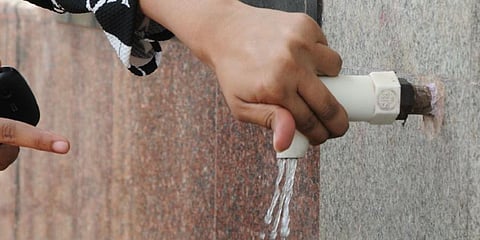

HYDERABAD: World Water Day is fast approaching. As a scientist researching water quality, Dr. Pabba Shivakrishna, Ph.D in Microbiology from Hyderabad and currently working for a water company, says, that water is under extreme threat from a growing population, increasing demands of agriculture and industry, and the worsening impacts of climate change.
Safe drinking water means the water that is free from contamination and does not represent any significant risk to health over and a lifetime of consumption. When they are forced to use toxic or polluted water, they are at risk of being fatally ill.
Theme of World Water Day 2021:
“Valuing water” is the theme of World Water Day 2021. Water value is far more than its price – water has an immense and complex value for our households, food, health, education, economics and the dignity of our natural environment. If we ignore all of these values, we risk mismanaging this finite value.
What is the solution for improvement water quality and access to water?
Increase awareness:
Try and gather as many facts as you can. How much water goes into making a simple cotton T-shirt? How many litres of water does the washing machine at home use, urges Shivakrishna who says more and more Hyderabadis are approaching him for report on water quality.
“Before they move into new homes, they are sending water samples. This is a good trend as it means we are more aware of what we are consuming,” he adds about the new trend. Use water cautiously: Water is no longer a bountiful resource. Use it well. Whether you are showering, brushing your teeth, or watering your garden, always try and minimise the amount of water you use.
Be curious:
Find out where exactly the water you use comes from. Yes, it magically appears when you turn on the tap, but where is its source? Discovering this will help you care more about this precious resource.
Warmer means drier:
Global warming is another important cause of water scarcity. When our average air temperature becomes warmer, water from rivers and lakes evaporates faster, which may contribute to the drying up of water bodies. Therefore, people who rely on those water bodies for drinking water significantly suffer from the consequences of global warming, affecting the local water supply.
Say no to dumping:
Illegal dumping is another significant reason for water shortages. Industries frequently dispose of their industrial garbage into nearby rivers and lakes since it is an easy and cheap way to get rid of this waste. It leads to serious water pollution, which may result in severe water scarcity for people who rely on those water bodies for the water supply.
Through soil, into the ground:
Soil pollution or illegal dumping can also cause groundwater pollution as harmful substances get washed through the soil into groundwater during rainfall. Locals who rely on clean groundwater suffer from severe levels of water scarcity if there is no alternative water supply in place.
Disasters effect water:
Natural disasters like the recent Hyderabad floods also cause severe water shortages for the local population since important public infrastructure may be destroyed. The severe natural disaster may entirely collapse the local water supply. At present, excessive levels of chemical fertilisers and pesticides are used to maximise crop yields.
However, it leads to serious soil pollution, which in turn translates into groundwater pollution and contributes to the water scarcity issue. It is crucial that farmers reduce the use of chemicals for farming to ensure clean water and reduced water shortage problem. Clean drinking water starts with a good sewage system. Without proper sanitation, the water in an area becomes ridden with disease and any number of other problems. By improving the sewage systems in these areas, we can prevent water scarcity from becoming any worse.
Succulents for greenery, with less water
As more and more people come to terms with the realities of climate crisis, they are trying to save water in everyday activities like gardening. A few green thumbs swear that growing succulents is a good way to enhance the aesthetic value of your gardens without spending much water. Shell Jhanb, the proprietor of ‘Pots N More’ who was in Hyderabad recently for a horticulture expo, said: “Succulent arrangements are the new bouquets. They do not need much water and do not wilt after three days. They are aesthetically as pleasing as flowers. You can propagate them easily through cuttings in a variety of containers. That is why, they are becoming popular among plant growers.”
What Hyderabadis are doing to save water
Aarti Agarwal, food blogger
(Inputs from Manju Latha Kalanidhi and Kakoli Mukherjee)